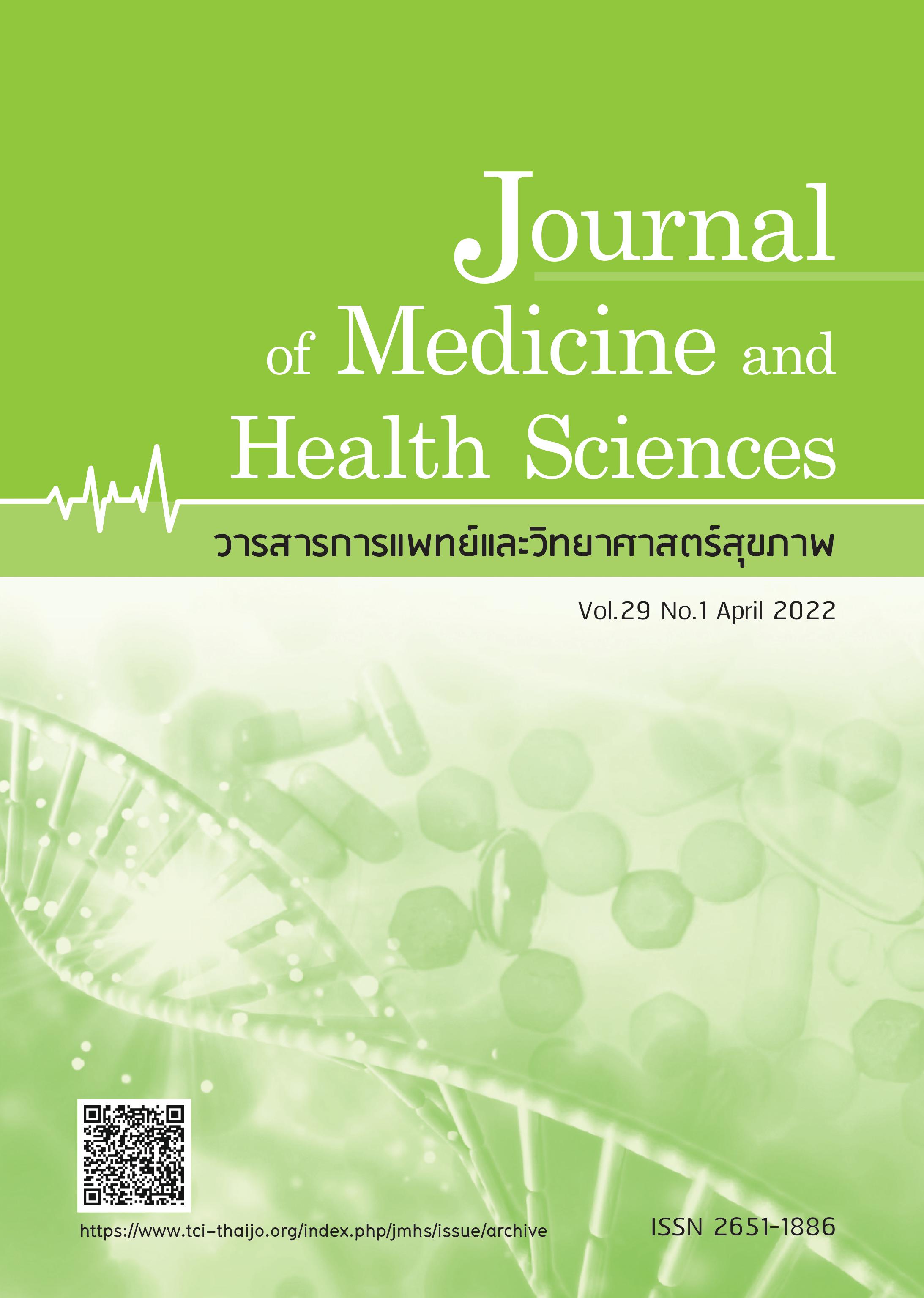Pterion and its location for neurosurgical approach: a cadaveric study in Southern Thailand
Keywords:
pterion, skull, surface anatomy, craniotomyAbstract
Abstract
The pterion is a sutural confluence area in the lateral section of the skull where the frontal, parietal, temporal, and sphenoid bones are connected. A knowledge of the exact location and anatomical landmarks of the pterion is crucial in surgical intervention to approach the anterior and middle cranial fossae. Therefore, the present study aims to determine the types and positions of pterion. First, sixty pterions from 30 cadaveric skulls were obtained. Second, the morphology and sutural patterns of the pterion were determined based on Murphy’s classification. The results found that the most common type of pterion among Southern Thai people in this study was the sphenoparietal type, followed by epipteric, frontotemporal and stellate types, respectively. Additionally, this study provided valuable data on the mean distance from the location of the pterion to five external landmarks, including the frontozygomatic suture, the mid-zygomatic arch, the external acoustic meatus, mastoid process, and the zygomatic angle; and two internal landmarks, the sphenoid ridge and the optic canal. All of the results in this study may be important for neurosurgery on the optimal bony aperture when neuronavigation devices are not available, and provide forensic anthropology information for further study.
References
Black S. External skull. In: Standring S, editor. Gray’s anatomy: the anatomical basis of clinical practice. 41st ed. New York: Elsevier Limited; 2016. p.416-28.
Kamath VG, Hande M. Reappraising the neurosurgical significance of the pterion location, morphology, and its relationship to optic canal and sphenoid ridge and neurosurgical implications. Anat Cell Biol
;52:406-13.
Murphy T. The pterion in the Australian aborigine. Am J Phys Anthropol 1956;14:225-44.
Ma S, Baillie LJM, Stringer MD. Reappraising the surface anatomy of the pterion and its relationship to the middle meningeal artery. Clin Anat 2012;25:330-9.
Ribas GC, Yasuda A, Ribas EC, et al. Surgical anatomy of microneurosurgical sulcal key points. Oper Neurosurg 2006;59:ONS-177-211.
Fournier HD, Dellière V, Gourraud JB, et al. Surgical anatomy of calvarial skin and bones--with particular reference to neurosurgical approaches. Adv Tech Stand Neurosurg 2006;31:253-71.
Tayebi Meybodi A, Benet A, Rodriguez Rubio R, et al. Comprehensive anatomic assessment of the pterional, orbitopterional, and orbitozygomatic approaches for basilar apex aneurysm clipping. Oper
Neurosurg (Hagerstown) 2018;15:538-50.
Yasargil MG, Antic J, Laciga R, et al. Microsurgical pterional approach to aneurysms of the basilar bifurcation. Surg Neurol 1976;6:83-91.
He H, Cai M, Li M, et al. Surgical techniques and the choice of operative approach for cranioorbital lesions. J Neurol Surg Part B: Skull Base 2020;81:686-93.
Fernandez-Miranda JC, Gardner PA, Snyderman CH, et al. Craniopharyngioma:
a pathologic, clinical, and surgical review. Head Neck 2012;34:1036-44.
Pratheesh R, Rajaratnam S, Prabhu K, et al. The current role of transcranial surgery in
the management of pituitary adenomas. Pituitary 2013;16:419-34.
Adib SD, Herlan S, Ebner FH, et al. Interoptic, trans-lamina terminalis, opticocarotid triangle, and caroticosylvian windows from mini-supraorbital, frontomedial, and pterional perspectives:
a comparative cadaver study with artificial lesions. Front Surg 2019;6:40.
Izumo T, Morofuji Y, Hayashi K, et al. Surgical treatment of ruptured anterior circulation aneurysms: comparative analysis of modified mini-pterional and standard pterional craniotomies. Neurol India 2019;67:1248-53.
Yagmurlu K, Safavi-Abbasi S, Belykh E, et al. Quantitative anatomical analysis and clinical experience with mini-pterional and mini-orbitozygomatic approaches for intracranial aneurysm surgery. J Neurosurg 2017;127:646-59.
Gnanakumar S, Abou El Ela Bourquin B, Robertson FC, et al. The world federation
of neurosurgical societies young neurosurgeons survey (part I): demographics, resources, and education. World Neurosurg X 2020;8:100083.
Apinhasmit W, Chompoopong S, Chaisuksunt V, et al. Anatomical consideration of pterion and its related references in Thai dry skulls for pterional surgical approach. J Med Assoc Thai
;94:205-14.
Chaijaroonkhanarak W, Woraputtaporn W, Prachaney P, et al. Classification and incidence of pterion patterns of Thai skulls. Int J Morphol 2017;35:1239-42.
Wang Q, Opperman LA, Havill LM, et al. Inheritance of sutural pattern at the pterion in Rhesus monkey skulls. Anat Rec A Discov Mol Cell Evol Biol 2006;288: 1042-9.
Matsumura G, Kida K, Ichikawa R, et al. Pterion and epipteric bones in Japanese adults and fetuses, with special reference to their formation and variations. Kaibogaku Zasshi 1991;66:462-71.
Eboh DEO, Obaroefe M. Morphometric study of pterion in dry human skull bones of Nigerians. Int J Morphol 2014;32:208-13.
Ruiz C, Souza G, Scherb T, et al. Anatomical variations of pterion: analysis of the possible anatomical variations of pterion in human skulls. J Morphol Sci 2016;33: 200-4.
Cimen K, Otag I, Cimen M. Pterion types and morphometry in Middle and South
Anatolian adult skulls. Rev Arg de Anat Clin 2019;11:8-17.
Knezi N, Stojsic DL, Adjic I, et al. Morphology of the pterion in Serbian population. Int J Morphol 2020;38:820-4.
Oguz O, Sanli SG, Bozkir MG, et al. The pterion in Turkish male skulls. Surg Radiol
Anat 2004;26:220-4.
Aksu F, Akyer SP, Kale A, et al. The localization and morphology of pterion in adult West Anatolian skulls. J Craniofac Surg 2014;25:1488-91.
Rao KEV, Rao BS, Vinila BHS. Morphology and morphometric analysis of pterion with its neurosurgical implications in pterional approach. Int J Anat Res 2017;5:3384-88.
Downloads
Published
How to Cite
Issue
Section
License

This work is licensed under a Creative Commons Attribution-NonCommercial-NoDerivatives 4.0 International License.



